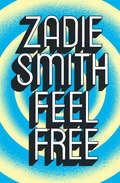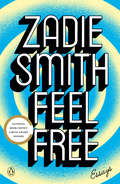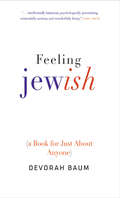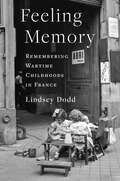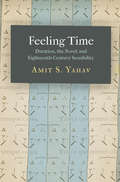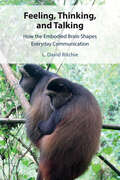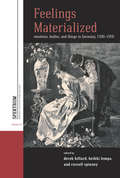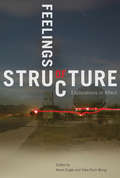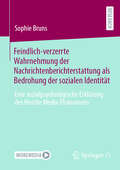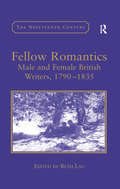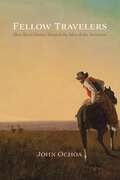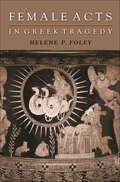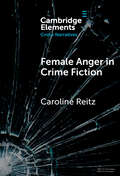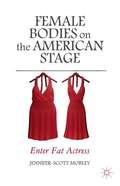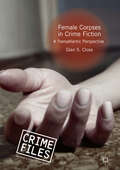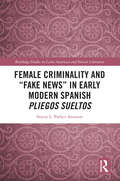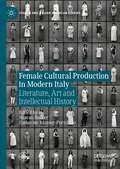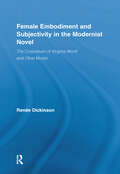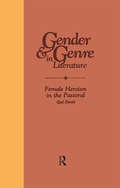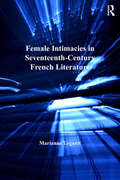- Table View
- List View
Feeding Frenzy: Attack Journalism and American Politics
by Larry J. SabatoThe author presents the phenomenon of "attack journalism." In describing "attack journalism," he exposes the harm done by the media to politicians and the harm done to the journalistic profession itself. The author examines the origins of feeding frenzies and gives lessons and possible remedies.
Feeding on Infinity: Readings in the Romantic Rhetoric of Internalization
by Joshua WilnerWhat "internalization" means for writers and critics of Romanticism, including Rousseau, Wordsworth, De Quincey, Baudelaire, Freud, Benjamin, and SedgwickWinner of the American Conference on Romanticism's Jean Pierre Barricelli Book Prize"Although defining Romanticism is a standing problem for literary history, some notion of internalization at the level of cultural tradition has recurrently been proposed as the solution to that problem... In this debate the notion of internalization tends to be handled... as a known quantity, whereas I am arguing that the notion itself remains obscure and thus that the problem of internalization and the problem of Romanticism may indeed, with respect to the discourse of literary history, be closely intertwined"—from Feeding on InfinityNotions of "internalization" play an important role in many contemporary fields of discourse, including literary history and theory, psychoanalysis, ideological critique, and learning theory in the social sciences. Indeed, the term "internalization" is pervasive and seems to answer a shared need of expression to such an extent that it is one of those technical words that has found its way into everyday use. But the meaning of this term and the continuities and discontinuities at work in its varied deployment have, for the most part, gone unanalyzed.In Feeding on Infinity, Joshua Wilner explores the power and limits of the discourse of internalization through the close reading of a variety of texts drawn from the Romantic tradition, a tradition which is both source for and oftentimes object of this discourse. Through the study of writers including Rousseau, Wordsworth, De Quincey, Baudelaire, Freud, Benjamin, and Sedgwick, he seeks to deepen our understanding of the problem of internalization, while situating its more or less explicit emergence as a problem in relation to the history of, in Gertrude Stein's phrase, "patriarchal poetics."Through patient attention to the transformations of rhetorical structures of representation and address performed by these works and to the frequent condensation of these transformations in figures of eating and drinking, Feeding on Infinity makes available to inquiry a surprisingly rich and largely unexplored network of connections within the "long" Romantic tradition. At the same time, it forges new links between deconstructive reading practices, psychoanalysis, and recent work in gender studies.
Feel Free
by Zadie SmithA timely, powerful collection of essays from one of our sharpest minds and most sparkling stylists. <p><p> How much joy can a person tolerate? How many kinds of boredom make up a life? Who owns the story of black America? Should Justin Bieber be more like Socrates? And why is there a dead art collector floating in the swimming pool? <p> Dazzlingly insightful, explosively funny and ever-timely, Zadie Smith is back with a second unmissable collection of essays. From German Old Masters to the new masters of East Coast rap, from social networks opening lines of communication to national referenda closing doors, Feel Free reaches out in all directions and draws back a rich feast of ideas. Here pop culture, high culture, social change and political debate all get the Zadie Smith treatment: dissected with razor-sharp intellect, set brilliantly against the context of the utterly contemporary, and considered with a deep humanity and compassion. <p> With the easy intimacy of a local and the piercing clarity of an outsider, Feel Free casts a sharp critical eye over the creative luminaries that have shaped our world: from J. G. Ballard to Karl Ove Knausgaard, Orson Welles to Charlie Kaufman, Joni Mitchell to Beyonce, and far beyond. And it considers the points of contact where the author herself meets this world, where the political meets the personal and critique meets memoir. This electrifying new collection showcases Zadie Smith as a true literary powerhouse, demonstrating once again her credentials as an essential voice of her generation.
Feel Free: Essays
by Zadie Smith<P>Arranged into five sections--In the World, In the Audience, In the Gallery, On the Bookshelf, and Feel Free--this new collection poses questions we immediately recognize. <P>What is The Social Network--and Facebook itself--really about? <P>"It's a cruel portrait of us: 500 million sentient people entrapped in the recent careless thoughts of a Harvard sophomore." <P>Why do we love libraries? <P>"Well-run libraries are filled with people because what a good library offers cannot be easily found elsewhere: an indoor public space in which you do not have to buy anything in order to stay." <P>What will we tell our granddaughters about our collective failure to address global warming? <P>"So I might say to her, look: the thing you have to appreciate is that we'd just been through a century of relativism and deconstruction, in which we were informed that most of our fondest-held principles were either uncertain or simple wishful thinking, and in many areas of our lives we had already been asked to accept that nothing is essential and everything changes--and this had taken the fight out of us somewhat."
Feeling Backward: Loss and the Politics of Queer History
by Heather LoveFeeling Backward weighs the costs of the contemporary move to the mainstream in lesbian and gay culture. While the widening tolerance for same-sex marriage and for gay-themed media brings clear benefits, gay assimilation entails other losses--losses that have been hard to identify or mourn, since many aspects of historical gay culture are so closely associated with the pain and shame of the closet.<P> Feeling Backward makes an effort to value aspects of historical gay experience that now threaten to disappear, branded as embarrassing evidence of the bad old days before Stonewall. It looks at early-twentieth-century queer novels often dismissed as "too depressing" and asks how we might value and reclaim the dark feelings that they represent. Heather Love argues that instead of moving on, we need to look backward and consider how this history continues to affect us in the present.<P> Through elegant readings of Walter Pater, Willa Cather, Radclyffe Hall, and Sylvia Townsend Warner, and through stimulating engagement with a range of critical sources, Feeling Backward argues for a form of politics attentive to social exclusion and its effects.
Feeling It: Language, Race, and Affect in Latinx Youth Learning
by Mary Bucholtz Dolores Inés Casillas Jin Sook LeeFeeling It brings together twelve chapters from researchers in Chicanx studies, education, feminist studies, linguistics, and translation studies to offer a cohesive yet broad-ranging exploration of the issue of affect in the language and learning experiences of Latinx youth. Drawing on data from an innovative social justice-oriented university-community partnership based in young people’s social agency and their linguistic and cultural expertise, the contributors are unified by their focus on a single year in the history of this partnership; their analytic focus on race, language, and affect in educational contexts; and their shared commitment to ethnography, discourse analysis, and qualitative methods, informed by participatory and social justice paradigms for research with youth of color. Designed specifically for use in courses, with theoretical framing by the co-editors and ethnographic contributions from leading and emergent scholars, this book is an important and timely resource on affect, race, and social justice in the United States. Thanks to its interdisciplinary grounding, Feeling It will be of interest to future teachers and to researchers and students in applied linguistics, education, and Latinx studies, as well as related fields such as anthropology, communication, social psychology, and sociology.
Feeling Jewish: (A Book for Just About Anyone)
by Devorah BaumIn this sparkling debut, a young critic offers an original, passionate, and erudite account of what it means to feel Jewish—even when you’re not. Self-hatred. Guilt. Resentment. Paranoia. Hysteria. Overbearing Mother-Love. In this witty, insightful, and poignant book, Devorah Baum delves into fiction, film, memoir, and psychoanalysis to present a dazzlingly original exploration of a series of feelings famously associated with modern Jews. Reflecting on why Jews have so often been depicted, both by others and by themselves, as prone to “negative” feelings, she queries how negative these feelings really are. And as the pace of globalization leaves countless people feeling more marginalized, uprooted, and existentially threatened, she argues that such “Jewish” feelings are becoming increasingly common to us all. Ranging from Franz Kafka to Philip Roth, Sarah Bernhardt to Woody Allen, Anne Frank to Nathan Englander, Feeling Jewish bridges the usual fault lines between left and right, insider and outsider, Jew and Gentile, and even Semite and anti-Semite, to offer an indispensable guide for our divisive times.
Feeling Memory: Remembering Wartime Childhoods in France (The Columbia Oral History Series)
by Lindsey DoddWhat did it feel like to be a child in France during World War II? Feeling Memory is an affective exploration of children’s lives in wartime France and the ways they are remembered.Lindsey Dodd draws on the recorded oral narratives of a hundred people to examine the variety of experiences children had during the war. She considers different aspects of remembering, underscoring the centrality of emotion to memory. This book covers a wide range of locations—the country and the city, Occupied France and the Free Zone—and situations—well-off and poor children, those separated from their families and those with them; it places Jewish children’s experiences alongside non-Jewish children’s. Against the backdrop of momentous events, readers encounter children playing, working, eating, thinking, doing, and feeling.An investigation of the emotions of history, Feeling Memory argues for the transformative potential of affect theory and affective methodologies in oral history and the history of everyday life. This book makes major contributions to the history of France during World War II, understandings of children’s lives in war, and the use of memory in historical and oral history analysis.
Feeling Time: Duration, the Novel, and Eighteenth-Century Sensibility
by Amit S. YahavLiterary historians have tended to associate the eighteenth century with the rise of the tyranny of the clock—the notion of time as ruled by mechanical chronometry. The transition to standardized scheduling and time-discipline, the often-told story goes, inevitably results in modernity's time-keeper societies and the characterization of modern experience as qualitatively diminished.In Feeling Time, Amit Yahav challenges this narrative of the triumph of chronometry and the consequent impoverishment of individual experience. She explores the fascination eighteenth-century writers had with the mental and affective processes through which human beings come not only to know that time has passed but also to feel the durations they inhabit. Yahav begins by elucidating discussions by Locke and Hume that examine how humans come to know time, noting how these philosophers often consider not only knowledge but also experience. She then turns to novels by Richardson, Sterne, and Radcliffe, attending to the material dimensions of literary language to show how novelists shape the temporal experience of readers through their formal choices. Along the way, she considers a wide range of eighteenth-century aesthetic and moral treatises, finding that these identify the subjective experience of duration as the crux of pleasure and judgment, described more as patterned durational activity than as static state.Feeling Time highlights the temporal underpinnings of the eighteenth century's culture of sensibility, arguing that novelists have often drawn on the logic of musical composition to make their writing an especially effective tool for exploring time and for shaping durational experience.
Feeling, Thinking, and Talking: How the Embodied Brain Shapes Everyday Communication
by L. David RitchieThe way the brain, body, and mind interact with social structure to shape communication has so far not received the attention it deserves. This book addresses this gap by providing a novel account of communication as a social, biological and neurological force. Combining theories from communication studies and psycholinguistics, and drawing on biological and evolutionary perspectives, it shows how communication is inherently both biological and social, and that language and the neural systems that support it have evolved in response to a complex social environment. It introduces a clear set of terms based on current research, and illustrates key concepts using real-life examples from everyday conversation - speaking to a number of current debates around the evolutionary and biological basis of language, and the relationship between language, cognition, and environment. Thought provoking and engaging, it will change the way we think about the relationship between communication and cognition.
Feelings Materialized: Emotions, Bodies, and Things in Germany, 1500–1950 (Spektrum: Publications of the German Studies Association #21)
by Derek Hillard Heikki Lempa Russell SpinneyOf the many innovative historiographical approaches to emerge during the twenty-first century, one of the most productive has been the nexus of theories and methodologies broadly defined as “the history of emotions.” While this conceptual toolkit has generated significant insights into the past, it has overwhelmingly focused on emotions as linguistic and semantic phenomena. This edited volume looks instead to the material aspects of emotion in German culture, encompassing body, literature, photography, aesthetics, and a variety of other themes.
Feelings of Structure: Explorations in Affect
by Karen Engle Yoke-Sum Wong<p>Sweatsuits and the apocalypse, the demands of a sofa, a life recalled through window frames, whale watching through cancer, the serendipity of geographical names … in Feelings of Structure, these are just some of the spaces and places, memories, and experiences addressed by the authors in writings that are multilevel explorations of the tangled-up nature of feeling and structure. <p>Inspired by Raymond Williams's classic essay "Structures of Feeling" and influenced by the current discussion of affect studies, this collection inverts Williams's influential concept to explore the ephemerality of feeling as working in concert with the grounding forces of materiality and history. Feelings of Structure is a collection of twelve original texts that explores the weight of diverse encounters with a variety of configurations, be they institutional, spatial, historical, or fantastical. Featuring writers from a range of disciplines, this book aims for textual evocation in subject matter and approach, with essays that encompass multiple methodologies, writing styles, and tones. <p>Experimental in nature, Feelings of Structure balances the need for concrete and specific observation with the ephemerality of experience.</p>
Feindlich-verzerrte Wahrnehmung der Nachrichtenberichterstattung als Bedrohung der sozialen Identität: Eine sozialpsychologische Erklärung des Hostile Media Phänomens
by Sophie BrunsIm Zentrum dieser Arbeit steht die Frage, wie Mitglieder von sozialen Gruppen auf die Nachrichtenberichterstattung zu einem Thema reagieren, welches für ihre soziale Gruppe relevant ist. Mit der Zielsetzung, die Rolle der sozialen Identität für die feindlich-verzerrte Wahrnehmung der Nachrichtenberichterstattung und deren Konsequenzen zu untersuchen, befasst sich die Autorin mit einer sozialpsychologischen Erklärung des Hostile Media Phänomens. Aufbauend auf einer theoretischen Modellierung folgt eine empirische Prüfung des Erklärungsmodells mittels einer quantitativen Befragung mit experimenteller Untersuchungsanlage. Die Ergebnisse verdeutlichen insbesondere die Bedeutung der wahrgenommenen Bedrohung der sozialen Identität für die Konsequenzen der feindlich-verzerrten Wahrnehmung der Nachrichtenberichterstattung. Es zeigt sich beispielsweise, dass Gruppenmitglieder eher bereit sind, Journalistinnen und Journalisten verbal abzuwerten, wenn sie sich durch deren Berichterstattung in ihrer sozialen Identität bedroht sehen.
Felicia Hemans: Selected Poems, Letters, Reception Materials
by Susan J. WolfsonThe first standard edition of the writings of Felicia Hemans (1793-1835), this volume marks a revival of interest in, and a new critical appreciation of, one of the most important literary figures of the early nineteenth century. A best-selling poet in England and America, Felicia Hemans was regarded as leading female poet in her day, celebrated as the epitome of national "feminine" values. However, this same narrow perception of her work eventually relegated Hemans to an obscurity lightened occasionally by parody and a sentimental enthusiasm for poems such as "The Landing of the Pilgrim Fathers" and "Casabianca." Only now is Hemans's work being rediscovered and reconsidered--for the complexity of its social and political vision, but also for its sounding of dissonances in nineteenth-century cultural ideals, and for its recasting of the traditional canon of male "Romantics."Offering readers a firsthand acquaintance with the remarkable range of Hemans's writing, this volume includes five major works in their entirety, along with a much-admired aggregate, Records of Woman. Hemans's letters, many published here for the first time, reflect her views of her contemporaries, her work, her negotiations with publishers, and her emerging celebrity, while reviews and letters from others--including Lord Byron, Walter Scott, and the Wordsworths--tell the story of Hemans's reception in her time. An introduction by editor Susan Wolfson puts these writings, as well as Hemans's life and work, into much-needed perspective for the contemporary reader.
Fellow Romantics: Male and Female British Writers, 1790–1835 (The Nineteenth Century Series)
by Beth LauBeginning with the premise that men and women of the Romantic period were lively interlocutors who participated in many of the same literary traditions and experiments, Fellow Romantics offers an inspired counterpoint to studies of Romantic-era women writers that stress their differences from their male contemporaries. As they advance the work of scholars who have questioned binary approaches to studying male and female writers, the contributors variously link, among others, Charlotte Smith and William Wordsworth, Mary Robinson and Samuel Taylor Coleridge, Felicia Hemans and Percy Bysshe Shelley, Jane Austen and the male Romantic poets. These pairings invite us to see anew the work of both male and female writers by drawing our attention to frequently neglected aspects of each writer's art. Here we see writers of both sexes interacting in their shared historical moment, while the contributors reorient our attention toward common points of engagement between male and female authors. What is gained is a more textured understanding of the period that will serve as a model for future studies.
Fellow Travelers: How Road Stories Shaped the Idea of the Americas (New World Studies)
by John OchoaRoad trips loom large in the American imagination, and stories from the road have been central to crafting national identities across North and South America. Tales of traversing this vast geography, with its singular landscape, have helped foster a sense of American exceptionalism. Examining three turning points that shaped exceptionalism in both Americas—the late colonial and early Republican period, expansion into the frontier, and the Cold War—John Ochoa pursues literary travelers across landscapes and centuries. At each historical crossroads, the nations of North and South invented or reinvented themselves in the shadow of empire. Travel accounts from these periods offered master narratives that shaped the notion of America’s postimperial future.Fellow Travelers recounts the complex, on-the-road relationships between travelers such as Lewis and Clark, Alexander von Humboldt and Aimé Bonpland, Huckleberry Finn and Jim, Kerouac’s Sal Paradise and Dean Moriarty, and the Che Guevara and Alberto Granado of The Motorcycle Diaries. Such journeys reflect concerns far larger than their characters: tensions between the voices of the rugged individual and the democratic many, between the metropolis and the backcountry, and between the intimate and the vast. Working across national literatures, Fellow Travelers offers insight into a shared process of national reinvention and the construction of modern national imaginaries.This book is freely available in an open access edition thanks to TOME (Toward an Open Monograph Ecosystem)—a collaboration of the Association of American Universities, the Association of University Presses, and the Association of Research Libraries—and the generous support of the Pennsylvania State University.
Female Acts in Greek Tragedy (Martin Classical Lectures #15)
by Helene P. FoleyAlthough Classical Athenian ideology did not permit women to exercise legal, economic, and social autonomy, the tragedies of Aeschylus, Sophocles, and Euripides often represent them as influential social and moral forces in their own right. Scholars have struggled to explain this seeming contradiction. Helene Foley shows how Greek tragedy uses gender relations to explore specific issues in the development of the social, political, and intellectual life in the polis. She investigates three central and problematic areas in which tragic heroines act independently of men: death ritual and lamentation, marriage, and the making of significant ethical choices. Her anthropological approach, together with her literary analysis, allows for an unusually rich context in which to understand gender relations in ancient Greece. This book examines, for example, the tragic response to legislation regulating family life that may have begun as early as the sixth century. It also draws upon contemporary studies of virtue ethics and upon feminist reconsiderations of the Western ethical tradition. Foley maintains that by viewing public issues through the lens of the family, tragedy asks whether public and private morality can operate on the same terms. Moreover, the plays use women to represent significant moral alternatives. Tragedy thus exploits, reinforces, and questions cultural clichés about women and gender in a fashion that resonates with contemporary Athenian social and political issues.
Female Anger in Crime Fiction (Elements in Crime Narratives)
by Caroline ReitzFeminist anger is having a moment, but the double meaning of 'mad' as angry and crazy has shaped the representation of women in popular crime fiction since Lady Audley burned down the house over 150 years ago. But when is anger just, when is it revenge, and when is it maddening? This Element will explore the ethics and efficacy of anger in female-centered crime fiction from its first stirrings in the 19th century through second wave feminism's angry, individualist heroes until today's current explosion of women who reject respectability and justification. It will also examine recent challenges to our understanding of the genre posed both by feminist care ethics and by intersectional crime fiction. This Element considers anger as the appropriate affect for women fighting for justice and explores how it shapes the representation of female detectives, relates to the crimes they investigate, and complicates ideas around justice.
Female Bodies on the American
by Jennifer-Scott MobleyThe fat female body is a unique construction in American culture that has been understood in various ways during the twentieth and early twenty-first centuries. Analyzing post-WWII stage and screen performances, Mobley argues that the fat actress's body signals myriad cultural assumptions and suggests new ways of reading the body in performance.
Female Corpses in Crime Fiction: A Transatlantic Perspective (Crime Files)
by Glen S. CloseThis book examines the central significance of sexualized female corpses in modern and contemporary Hispanic and Anglophone crime fiction. Beginning with the foundational detective fictions of the nineteenth century, it draws from diverse subgenres to describe a transatlantic tradition of necropornography characterized by lascivious interest in female cadavers, dissection, morgues, femicide, and snuff movies. Hard-boiled and police procedural classics from the U.S. and the U.K. are juxtaposed with texts by established Spanish and Spanish American genre masters and with obscure works that prefigure the contemporary transmedial boom in corpse-centered fictions. The rhetoric and aesthetics of necropornographic crime fiction are related to those of popular crime journalism and forensic-science television dramas. This study argues that crime fiction has long fixated disproportionately on the corpses of beautiful young white women and continues to treat their deaths and autopsies as occasions for male visual pleasure, male subjective self-affirmation and male homosocial bonding.
Female Criminality and “Fake News” in Early Modern Spanish Pliegos Sueltos (Routledge Studies in Latin American and Iberian Literature)
by Stacey L. Parker AronsonThis book studies the Early Modern Spanish broadsheet, the tabloid newspaper of its day which functioned to educate, entertain, and indoctrinate its readers, much like today’s "fake news." Parker Aronson incorporates a socio-historical approach in which she considers crime and deviance committed by women in Early Modern Spain and the correlation between crime and the growth of urban centers. She also considers female deviance more broadly to encompass sexual and religious deviance while investigating the relationship between these pliegos sueltos and the transgressive and disruptive nature of female criminality. In addition to an introduction to this fascinating subgenre of Early Modern Spanish literature, Parker Aronson analyzes the representations of women as bandits and highway robbers; as murderers; as prostitutes, libertines, and actors; as Christian renegades; as enlaved people; as witches; as miscegenationists; and as the recipients of punishment.
Female Cultural Production in Modern Italy: Literature, Art and Intellectual History (Italian and Italian American Studies)
by Sharon Hecker Catherine Ramsey-PortolanoThis book is the first critical interdisciplinary examination in English of Italian women’s contributions to intellectual, artistic, and cultural production in modern Italy. Examining commonalities and diversities from the country’s Unification to today, the volume provides insight into the challenges that Italian women engaged in cultural production have faced, and the strategies they have deployed in order to achieve their objectives. The essays address a range of issues, from women’s self-identification and public ownership of their professional roles as laborers in the intellectual and cultural realm, to questions about motherhood and financial remuneration, to the role of creative foreign women in Italy. Through critical analysis and direct testimony from new and typically marginalized voices, including an Arab-Italian writer, an Italian-Dominican filmmaker, and a transgender activist, new forms of ongoing struggle emerge that redefine the culturally diverse landscape of female intellectual and creative production in Italy today. The volume rethinks a solely national “Made in Italy” reading of the subject of female intellectual labor, demonstrating instead the wide network of influences and relationships that have existed for Italian women in their professional aspirations.
Female Embodiment and Subjectivity in the Modernist Novel: The Corporeum of Virginia Woolf and Olive Moore (500 Tips)
by Renée DickinsonThis study considers the work of two experimental British women modernists writing in the tumultuous interwar period--Virginia Woolf and Olive Moore--by examining four crucial incarnations of female embodiment and subjectivity: female bodies, geographical imagery, national ideology and textual experimentation. Dickinson proposes that the ways Mrs. Dalloway, and The Waves by Virginia Woolf and Spleen and Fugue by Olive Moore reflect, expose and criticize physical, geographical and national bodies in the narrative and form of their texts reveal the authors’ attempts to try on new forms and experiment with new possibilities of female embodiment and subjectivity.
Female Heroism in the Pastoral (Gender and Genre in Literature #Vol. 2)
by Gail DavidThe past decade has given us explorations of such forms as the Bildungsroman, the Kunstleroman, the utopian and Gothic novel as women have written them; studies are even now emerging of the female-authored elegy, sonnet sequence and other pure and mixed poetic modes. Women’s work in non-fiction prose and in the dramatic genres is being resurrected and reassessed. At the same time, feminist critics continue to deconstruct women as signs in patriarchal literary forms, explaining the effect of male gender on structures of signification, the narrative and stylistic codes of genre. This series welcomes such studies, encouraging as well accounts of sexuality and textual inheritance, the influence of female authorship on the evolution of a genre or the creation of a new genre, and challenges to genre theory from a gender perspective.
Female Intimacies in Seventeenth-Century French Literature (Women And Gender In The Early Modern World Ser.)
by Marianne LegaultExamining literary discourses on female friendship and intimacy in seventeenth-century France, this study takes as its premise the view that, unlike men, women have been denied for centuries the possibility of same sex friendship. The author explores the effect of this homosocial and homopriviledged heritage on the deployment and constructions of female friendship and homoerotic relationships as thematic narratives in works by male and female writers in seventeenth-century France. The book consists of three parts: the first surveys the history of male thinkers' denial of female friendship, concluding with a synopsis of the cultural representations of female same-sex practices. The second analyzes female intimacy and homoerotism as imagined, appropriated and finally repudiated by Honoré d'Urfé's pastoral novel, L'Astrée, and Isaac de Benserade's seemingly lesbian-friendly comedy, Iphis et Iante. The third turns to unprecedented depictions of female intimate and homoerotic bonds in Madeleine de Scudéry's novel Mathilde and Charlotte-Rose de Caumont de La Force's fairy tale Plus Belle que Fée. This study reveals a female literary genealogy of intimacies between women in seventeenth-century France, and adds to the research in lesbian and queer studies, fields in which pre-eighteenth-century French literary texts are rare.


